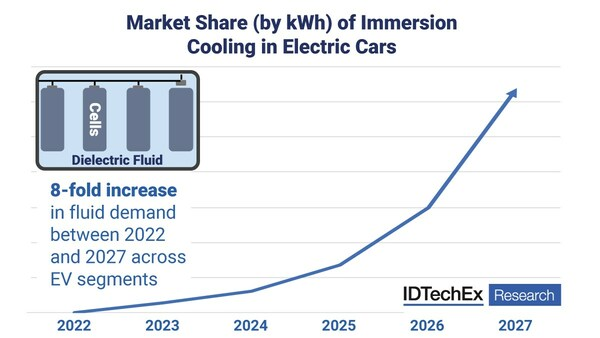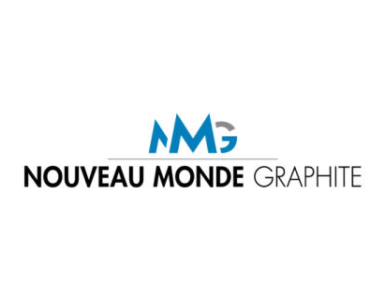IDTechEx discuss why immersion cooling might not be the final battery cooling solution.
Battery thermal management is a critical component to an electric vehicles (EVs) operation. Cells need to be kept cool when under load from driving and charging or kept warm during cold ambient conditions. This enables more efficient operation of the batteries and improves safety.
This is typically done via a water cold plate at the base of the battery pack or via water coolant channels between the cells. Immersion cooling is often touted as the next-generation thermal management technology, but there are certainly barriers to adoption. Based on IDTechEx’s latest research report, “Thermal Management for Electric Vehicles 2023-2033“, this article looks at the benefits, drawbacks, current market adoption, and potential for the future.
Benefits
🔥 What about we co-host a webinar? Let's educate, captivate, and convert the battery economy!
Batteries News is the global go-to online magazine for the battery industry, we can help you host impactful webinars that become a global reference on your topic and are an evergreen source of leads. Click here to request more details
As the name suggests, immersion cooling involves having the battery cells directly immersed in a dielectric fluid. The immediate benefit is the superior thermal contact and homogeneity; the fluid contacts much more of the cell directly than a cold plate or coolant channel would, helping eliminate a non-uniform temperature gradient. Depending on the fluid used, it can act to extinguish a fire in the event of thermal runaway.
Not so obviously, immersion can lead to the removal of several components, such as the cold plate, thermal interface materials, condenser, and chiller.
The more effective thermal management helps enable fast charging, an often publicized factor for selling an EV.
Drawbacks
The initial concern for most is the weight of the fluids. This is certainly true for heavy hydrofluoroether products that often have densities above 1.5g/cm3. However, this can be mitigated somewhat by removing other components (as above) or the use of other types of dielectric fluids like synthetic esters or other oil mixtures with a density below that of water (1g/cm3).
The argument is complicated by the need for enough space between the cells for fluid flow; this may not directly impact weight but could reduce the volumetric energy density of the pack.
Dielectric fluids used in this application typically have a greatly reduced thermal conductivity and specific heat than water-glycol.
This means a higher fluid flow rate may be required; couple this with fluids that are sometimes more viscous than water and have different chemical compatibility, and this leads to a greater requirement on the fluid pumps and coolant hoses/seals. Speaking of which, typical battery modules are not designed to contain fluid; therefore, the modules have to be redesigned to avoid leakage and ensure no corrosion takes place.
Who Is Using It?
Immersion cooling in EVs has remained quite limited over the past few years. Early implementation has occurred in a few market segments, including high-performance hybrids such as McLaren and plans for Mercedes AMG in the future, relatively niche luxury battery electric vehicles like Rimac and Faraday Future, and construction equipment through companies such as XING Mobility and John Deere.
A factor these segment share is the need for a very power-dense battery but not necessarily a very energy dense one (for hybrids and construction).
The above applications have focused on single-phase immersion cooling, but players like Carrar are focusing on two-phase, suggesting that it can provide even better thermal performance, lower amounts of fluid, and lower system pressure. However, two-phase immersion is certainly at a lower state of deployment in EVs today.
There has been a much bigger push on the material supplier side, with several existing material companies producing fluids for these applications and creating partnerships to further develop the technology.
This has been seen with players like Castrol partnering with XING Mobility and FUCHS Lubricants partnering with Exoes. However, 3M have announced the halt of per- and polyfluoroalkyl substance (PFAS) by 2025, including its Novec fluid used for immersion applications.
Where Will It Be Used?
Immersion cooling certainly proposes significant benefits to the EV market. IDTechEx sees the immediate benefits for power dense applications, such as high-performance hybrids, motorsport, and construction. Luxury high-performance vehicles do not have to contend with high volume manufacturing scales and also present a good immediate opportunity for immersion.
For greater adoption into the mass-market automotive sector, a much more serious overhaul of the status quo would be required. Water-glycol cold plates are a proven technology that has demonstrated high charging powers.
Given automotive development timescales IDTechEx is not expecting significant immersion deployment in the near future but sees a greater opportunity later into this decade with a 9-fold yearly fluid demand increase between 2026 and 2033, but remaining a relatively small part of the overall automotive thermal management market.
IDTechEx’s report, “Thermal Management for Electric Vehicles 2023-2033“, takes a deep dive into immersion cooling, looking at the benefits, drawbacks, current adoption, and future adoption with 10-year market forecasts. Fluids from several material players are benchmarked against each other in terms of thermal performance, mechanical properties, and costs.
The report also covers the thermal management landscape for EVs more generally, looking at battery, motor, and power electronics and the trends associated with each component.
To find out more about this IDTechEx report, including downloadable sample pages, please visit www.IDTechEx.com/TMEV.
Upcoming Free-to-Attend Webinar
Thermal Management Opportunities in Emerging Technology Markets
Dr James Edmondson, Principal Technology Analyst at IDTechEx and author of this report, will be presenting a webinar on the topic on Wednesday 15 March 2023 – Thermal Management Opportunities in Emerging Technology Markets.
This webinar will take a look at thermal management in several emerging or developing technologies to provide insight into the trends in these markets. The webinar will cover markets including:
- Electric vehicles (thermal management and fire protection)
- ADAS (advanced driver-assistance systems)
- 5G infrastructure
- Data centers
- Consumer electronics
- Combined EMI shielding and TIM options
Click here to find out more about this webinar.
About IDTechEx
IDTechEx guides your strategic business decisions through its Research, Subscription and Consultancy products, helping you profit from emerging technologies. For more information, contact research@IDTechEx.com or visit www.IDTechEx.com.
READ the latest Batteries News shaping the battery market
IDTechEx Discuss Why Immersion Cooling Might Not be the Final Battery Cooling Solution, bOSTON, February 23,2023








